Related Research Articles

The 82nd Airborne Division is an airborne infantry division of the United States Army specializing in parachute assault operations into denied areas with a U.S. Department of Defense requirement to "respond to crisis contingencies anywhere in the world within 18 hours". Based at Fort Bragg, North Carolina, the 82nd Airborne Division is part of the XVIII Airborne Corps. The 82nd Airborne Division is the U.S. Army's most strategically mobile division.

James Maurice Gavin, sometimes called "Jumpin' Jim" and "the jumping general", was a senior United States Army officer, with the rank of lieutenant general, who was the third Commanding General (CG) of the 82nd Airborne Division during World War II. During the war, he was often referred to as "The Jumping General" because of his practice of taking part in combat jumps with the paratroopers under his command; he was the only American general officer to make four combat jumps in the war.
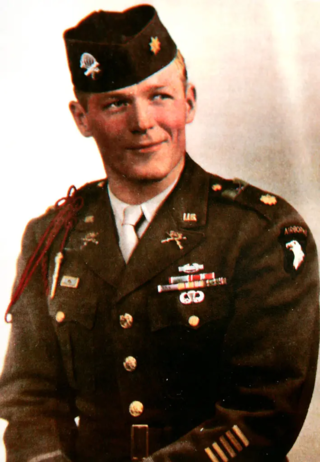
Richard Davis Winters was an officer of the United States Army and a decorated war veteran. He is best known for having commanded Easy Company of the 2nd Battalion, 506th Parachute Infantry Regiment, part of the 101st Airborne Division, during World War II. He was eventually promoted to major and put in command of the 2nd Battalion.

The Brécourt Manor Assault during the U.S. parachute assault of the Normandy Invasion of World War II is often cited as a classic example of small-unit tactics and leadership in overcoming a larger enemy force.
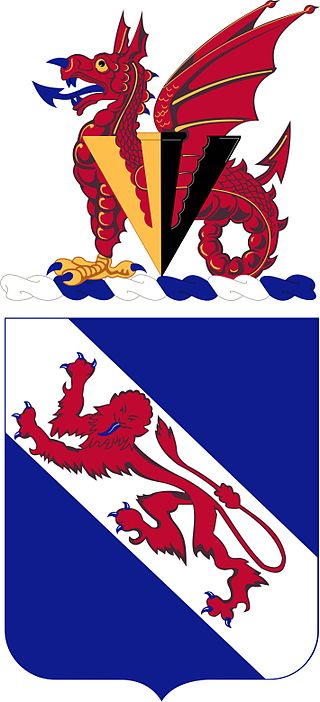
The 508th Infantry Regiment is an airborne infantry regiment of the United States Army, first formed in October 1942 during World War II. The 508th is a parent regiment under the U.S. Army Regimental System, and two battalions from the regiment are currently active: the 1st Battalion, 508th Parachute Infantry Regiment is assigned to the 3rd Brigade Combat Team, 82nd Airborne Division, and the 2nd Battalion, 508th Parachute Infantry Regiment is assigned to the 2nd Brigade Combat Team, 82nd Airborne Division. The regiment served in combat during World War II, and regimental elements have served in combat in the Dominican Republic, Vietnam, Grenada, Panama, Iraq and Afghanistan.
The 502nd Infantry Regiment, previously titled the 502nd Parachute Infantry Regiment, is an infantry regiment of the United States Army. The regiment was established shortly after U.S. entry into World War II, and was assigned as a regiment of the 101st Airborne Division, "The Screaming Eagles", one of the most decorated formations of the U.S. Army. The regiment saw substantial action in the European Theater of World War II and was inactivated in 1945, shortly after the end of the war. Reactivating in a new form in 1956, the 502nd Infantry has served in the Vietnam War, the Persian Gulf War, Iraq War, War in Afghanistan, and Operation Inherent Resolve in Iraq. Since 1974, the regiment has been classified as an Air Assault unit. Currently, its 1st and 2nd battalions are active. Both battalions are assigned to the 2nd Brigade Combat Team, 101st Airborne Division.

The 507th Parachute Infantry Regiment, now the 507th Infantry Regiment, is an airborne infantry regiment of the United States Army. The regiment was initially assigned to the 82nd Airborne Division in World War II before transferring to the 17th Airborne Division. Now 1st Battalion, 507th Infantry Regiment is part of the United States Army Infantry School, subordinate to its Airborne and Ranger Training Brigade, responsible for the Army's Basic Airborne School, Jumpmaster School, Pathfinder School, and the "Silver Wings" Command Exhibition Parachute Team.
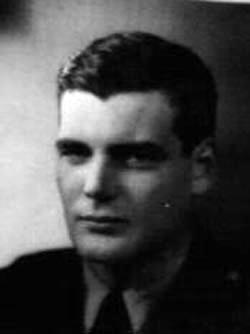
Captain Lewis Nixon III was a United States Army officer who, during World War II, served at the company, battalion, and regimental level with the 506th Parachute Infantry Regiment, 101st Airborne Division. Nixon was portrayed in the HBO miniseries Band of Brothers by Ron Livingston.

The 505th Parachute Infantry Regiment, originally the 505th Infantry Regiment, is an airborne infantry regiment of the United States Army, one of four infantry regiments of the 82nd Airborne Division of the United States Army, with a long and distinguished history.

The 504th Infantry Regiment, originally the 504th Parachute Infantry Regiment, is an airborne forces regiment of the United States Army, part of the 82nd Airborne Division, with a long and distinguished history. The regiment was first formed in mid-1942 during World War II as part of the 82nd Airborne Division and saw service in Sicily, Italy, Anzio, the Netherlands, Belgium and Germany.
The 513th Parachute Infantry Regiment was an airborne infantry regiment of the United States Army, raised during World War II. The 513th formed part of the 17th Airborne Division and participated in the European Campaign, fighting in the latter stages of the Battle of the Bulge in January 1945 and parachuted into Germany in Operation Varsity in March, in the largest airborne drop of the war. The regiment returned to the United States in September 1945 where it was inactivated.
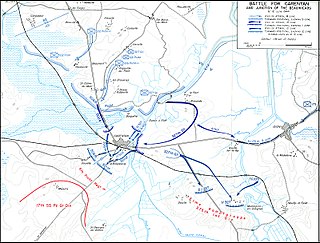
The Battle of Carentan was an engagement in World War II between airborne forces of the United States Army and the German Wehrmacht during the Battle of Normandy. The battle took place between 6 and 13 June 1944, on the approaches to and within the town of Carentan, France.
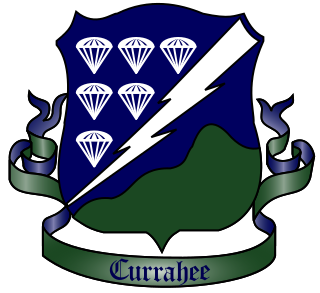
E Company, 2nd Battalion of the 506th Parachute Infantry Regiment of the 101st Airborne Division, the "Screaming Eagles", is a company in the United States Army. The company was referred to as "Easy" based on the WWII phonetic alphabet because it was the fifth lettered company in the 506th. The experiences of its members during World War II are the subject of the HBO miniseries Band of Brothers based on the book of the same name by historian Stephen Ambrose.

The 501st Infantry Regiment, previously the 501st Parachute Infantry Regiment and 501st Airborne Infantry Regiment, is an airborne forces regiment of the United States Army with a long history, having served in World War II and the Vietnam War, both as part of the 101st Airborne Division, as well as the War in Afghanistan. It is the first airborne unit by designation in the United States Armed Forces. Its 1st Battalion is assigned to the 2nd Infantry Brigade Combat Team (Airborne), 11th Airborne Division, located at Fort Richardson, Alaska. Its 2nd Battalion is assigned to the 1st Brigade Combat Team, 82nd Airborne Division, located at Fort Bragg, North Carolina.

Melvin O. Handrich was a soldier in the U.S. Army during both World War II and the Korean War. He posthumously received the Medal of Honor for his actions on August 25 and 26, 1950, during the Battle of Battle Mountain, part of the Battle of Pusan Perimeter. He is buried at Little Wolf Cemetery in Manawa, Waupaca County, Wisconsin.

The U.S. airborne landings in Normandy were the first U.S. combat operations during Operation Overlord, the invasion of Normandy by the Western Allies on June 6, 1944, during World War II. Around 13,100 American paratroopers of the 82nd and 101st Airborne Divisions made night parachute drops early on D-Day, June 6, followed by 3,937 glider troops flown in by day. As the opening maneuver of Operation Neptune the two American airborne divisions were delivered to the continent in two parachute and six glider missions.
Mission Boston was a parachute combat assault at night by Major General Matthew Ridgway's U.S. 82nd "All American" Airborne Division on June 6, 1944, part of the American airborne landings in Normandy during World War II. Boston was a component element of Operation Neptune, the assault portion of the Allied invasion of Normandy, codenamed Operation Overlord. 6,420 paratroopers jumped from nearly 370 C-47 Skytrain troop carrier aircraft into an intended objective area of roughly 10 square miles (26 km2) located on either side of the Merderet river on the Cotentin Peninsula of France, five hours ahead of the D-Day landings.

First Sergeant Leonard Alfred Funk Jr. was a United States Army Medal of Honor recipient and one of the most decorated soldiers and paratroopers of World War II. While serving with the 508th Parachute Infantry Regiment, then part of the 82nd Airborne Division, he also received the Distinguished Service Cross, Silver Star, Bronze Star Medal, and three Purple Hearts.

The capture of the Caen canal and Orne river bridges was an operation by airborne forces of the British Army that took place in the early hours of 6 June 1944 as part of the Normandy landings of the Second World War. The objective was to capture intact two road bridges in Normandy across the River Orne and the Caen canal, providing the only exit eastwards for British forces from their landing on Sword Beach. Intelligence reports said both bridges were heavily defended by the Germans and wired for demolition. Once captured, the bridges had to be held against any counter-attack, until the assault force was relieved by commandos and other infantry advancing from the landing beach.
Kenneth "Rock" Merritt is known for his service with the 508th Parachute Infantry Regiment, especially during World War II. As a parachutist, he made jumps during D Day, Operation Market Garden and the Battle of the Bulge.
References
- ↑ General Matthew B. Ridgway. "D-Day Minus One: U.S. Paratroopers Leave for France". Rjgeib.com. Retrieved 2013-06-25.
- ↑ Stephen Ambrose. "The Kids Who Changed the World". Rjgeib.com. Retrieved 2013-06-25.
- ↑ Ambrose, Stephen E. (July 13, 1998). "The Kids Who Changed the World". Newsweek. Retrieved 2013-06-25.
- ↑ "The 508th Parachute Infantry Regiment(PIR) Trooper Pictures during World War II". Ww2-airborne.us. Retrieved 2013-06-25.